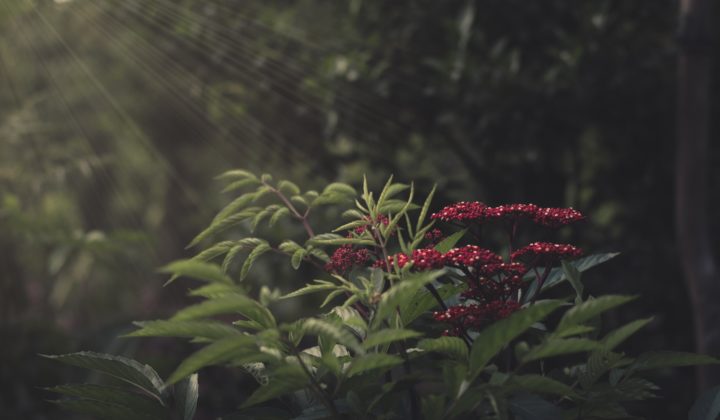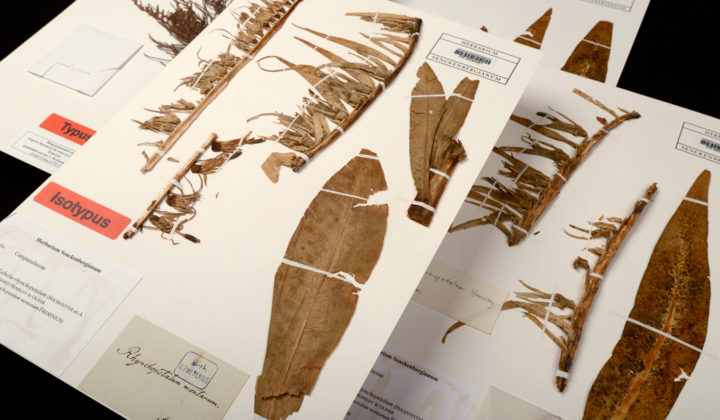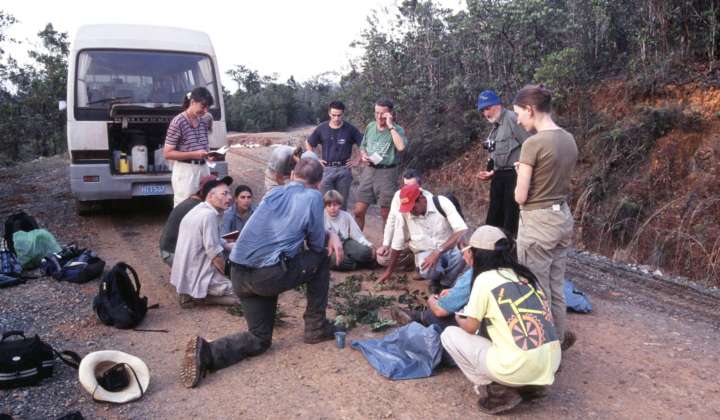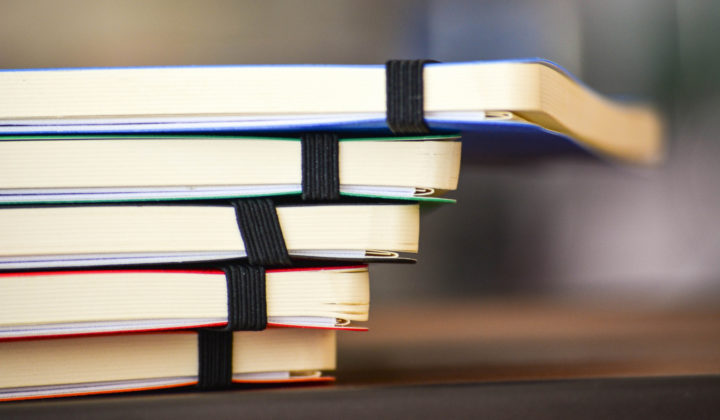
Bryophytes from the herbarium of Alfons Schäfer-Verwimp
27.05.2024
In 2024, we were again able to take over moss specimens from the herbarium of Alfons Schäfer-Verwimp. After a working visit to Schäfer-Verwimp (21-24 May), our honorary fellow Gerhard Winter was able to bring over 2,100 mosses identified to species, 190 phanerogams and a large number of indeterminate lichens, ferns and lycopods from all parts of the world to Frankfurt.
Since 2014, A. Schäfer-Verwimp has thus donated around 12,300 moss specimens, including particularly valuable specimens, to our herbarium and is currently the largest donor to our moss herbarium. Cordial thanks!
The specimens are entered by G. Winter into the Senckenberg database SeSam and successively inserted into the moss herbarium.
Lichens in the science slam
18.04.2024
A science slam entitled “Um uns die Natur” took place in the “Neue Kaiser” on 15 April as part of an unusual collaboration with the Frankfurt Opera and Museum Orchestra. Christian Printzen alias “Dr. Seltsam” represented the botany department with a slam on his little favourites, lichens, in a colourful bouquet of topics (pavement vegetation, deep-sea isopods, pond turtles…).
Position “Scientist and Curator of Vascular Plants” announced
12.04.2024
The position, which includes the scientific curation of the Phanerogam collection in the Herbarium Senckenbergianum (FR) has just been advertised (see announcement). The previous holder of the position was Dr Stefan Dressler.
Prof. Dr. Stefan Wanke new head of department
10.04.2024
Stefan Wanke has been appointed to the W3 professorship “Biodiversity of Angiosperms” at Goethe University and took up his position on April 1, 2024. As before, the professor is in personal union also head of the Department of Botany and Molecular Evolution with Herbarium Senckenbergianum (FR) and Grunelius-Möllgaard Laboratory.
After early work at a Leibniz Institute (civilian service at the Museum König in Bonn), Stefan Wanke studied biology in Bonn and then moved to the TU Dresden, where he obtained his doctorate in botany in 2007. After a PostDoc period there, a research stay followed at Philadelphia State University, USA, and finally he returned to TU Dresden as a research group leader and head of the molecular laboratory. In 2012 followed his habilitation in botany and in 2017 his appointment as professor. Since 2018 he is a member of the Saxonian Academy of Sciences.
His scientific focus is on the evolution and systematics of the Piperaceae, Aristolochiaceae, Hydrangeaceae and Bromeliaceae as well as the holoparasitic Hydnoraceae, and generally the mechanisms of genetical evolution in angiosperms. The geographical focus lies on the Neotropics and East and South Africa.
“Biodiversity mapping of the city of Frankfurt”: new, long-term agreement between Senckenberg and the city of Frankfurt am Main
13.03.2024
Since 1985, the biodiversity mapping working group from our department has been carrying out biodiversity monitoring for the entire city area, combined with in-depth investigations, the development of conservation concepts and success assessment of conservation measures. The city of Frankfurt’s new species and biotope protection concept is largely based on the data and analyses from our biodiversity mapping. In 2023, the tasks and objectives of the biodiversity mapping were updated with the City of Frankfurt’s environmental department, and the results form the basis of a new, long-term agreement on biodiversity monitoring between Senckenberg and the city of Frankfurt (here is the joint press release).
The focus of the new research co-operation is the regular biodiversity mapping of the city area, combined with in-depth diversity studies in areas relevant to nature conservation, monitoring of target and responsible species, development of conservation concepts, continuation of the online “Flora Frankfurt”, and assessing the consequences of climate and land use change on flora and habitats in permanent observation plots. Fabian Schrauth took over the coordination of the project, which continues to be part of the Botany and Molecular Evolution Research department, in 2024. The team also includes Dirk Bönsel, Franzisca Haffner and Georg Zizka.
Dr Indra Starke-Ottich leaves the biodiversity mapping department
13.03.2024
Dr Indra Starke-Ottich, the long-standing coordinator of biodiversity mapping and author of numerous publications on Franfurt’s “Stadtnatur”, has left the project and Senckenberg at the beginning of 2024 at her own request, but will continue to work in the field of biodiversity monitoring and nature and species conservation. Many thanks for her many years of successful and dedicated work!
Working meeting on the new edition of the “Rote Liste der Flechten Deutschlands”
22.02.2024
On February 1 and 2, 2024, 17 editors of the “Rote Liste der Flechten Deutschlands” and five employees of the German Red List Centre met in the Botany Department to discuss the threat assessments for around 100 particularly problematic species. Two other experts were connected online.
Approximately 2,200 lichen species and 600 lichen-inhabiting fungi species are known from Germany to date. However, the number of species is constantly increasing due to new discoveries and better systematic research, a clear sign that even rich countries like Germany do not have an overview of their biodiversity for many organisms.
Lichens are good indicators of environmental damage caused by humans, regardless of whether it is air pollution, over-fertilization, forestry and agricultural interventions or land sealing. Many species that were common a hundred years ago are now severely decimated or even extinct, while recently insensitive, mostly nitrogen-loving species have been spreading rapidly.
Claudia Burck visited the moss collection with her husband on January, 26th
01.02.204
Mrs. Burck is the great-granddaughter of Otto Burck (1873-1966), who was honorary section head of the botanical collections from 1921 to 1956 and made a key contribution to the development of the bryological collection. She had made the purchase of a modern binocular for botany possible through a condolence donation on the occasion of her father’s funeral. During this visit, Mrs. Burck was able to inspect our comparative collection of mosses, which Otto Burck had compiled during his 40 years of work for Senckenberg. This herbarium in bound volumes also contains microscopic specimens and was the basis for his extensive 1947 monograph “Die Laubmoose Mitteleuropas”.
Return after 41 years …
11.01.2024
On January 9, 2024, Brigitte Haustein and her husband handed over duplicates of Ruprecht Düll’s moss collections from North America to the Herbarium Senckenbergianum. Brigitte Haustein worked in our department on mosses for about a year in 1982.
Congratulations!
11.01.2024
On January 8, 2024, our long-time volunteer Annemarie Bähr celebrated her 100th birthday. Mrs. Bähr worked at the herbarium for over 20 years, until after her 90th birthday. We wish her all the best for the new year!
Acquisition of the Peter Rességuier collection
11.01.2024
In December 2023, around 3,500 herbarium specimens were acquired from Peter Rességuier (Marktheidenfeld). His entire collection is now in the Senckenberg herbarium. It includes phanerogams and cryptogams from Germany (Spessart and Rhön), Switzerland, France, Iceland, Tanzania, N-Africa and Peru.
Collecting trip to Taiwan
02.01.2024
From October 15 to 30, 2023, our honorary researcher Gerhard Winter and Alfons Schäfer-Verwimp collected bryophytes in Taiwan at the invitation of the National Taiwan Museum and the Taiwan Biodiversity Research Institute. This, his 3rd collecting trip, was again organized and financed by the two institutes. All specimens were photographed before collecting; it is planned to publish an illustrated brochure on the mosses of Dasyueshan. According to the agreements, Winter was able to take the specimens to Germany for identification, after which they will be divided up: one half for a herbarium in Taiwan (TAIM or TAIE) and one half for the Herbarium Senckenbergianum (FR). For newly described species, the holotype goes to Taiwan, the isotype remains at Senckenberg, as with Frullania dasyueshanensis Schäf.-Verw. & Gerh. Winter 2020.
Gouaches by Elisabeth Schultz at the Palmengarten
06.12.2023
In the exhibition “Orchids – Evolution and Perfection” in the Palmengarten (Gallery West at the Palm house, 28.09.2023 – 28.01.2024), which is well worth seeing, the orchid flora of Frankfurt in the 19th century is presented with gouaches by the painter Elisabeth Schultz (1817-1898). She documented a total of 31 orchid species in 35 sheets. Only 11 species still occur in the wild in Frankfurt today (these gouaches are framed in white in the exhibition), 20 species have been lost (brown frame). The entire work of 1262 plant pictures of Frankfurt’s flora is part of the botanical collections of the Herbarium Senckenbergianum in Frankfurt.
Maxillaria and Epidendrum in the Herbarium FR
06.11.2023
Klaus Area Rug has revised the specimens of the orchid genera Epidendrum and Maxillaria in the FR herbarium as part of a recently completed bachelor thesis at the TU Darmstadt. Epidendrum is represented by 121 herbarium specimens and 51 species, Maxillaria by 78 specimens and 19 species; 49 mostly purely vegetative specimens could not be clearly assigned to a species. The geographical focus of the collection is Bolivia, Venezuela and Central America/Caribbean. All examined specimens will soon be part of the SeSam database with specimen data and high-resolution scans.
Botanists’ meeting 2023 in Jena
04.10.2023
This year’s meeting of Senckenberg botanists took place in Jena (September 25-26). With almost 30 participants, it was probably better attended than ever before, even though Stefan Dressler, a founding member of these meetings, was sorely missed.
In addition to herbarium-related topics, planned and ongoing joint research and digitization projects were discussed. Likewise, the further development of scientific portals with botanical content, where great progress has now been made in the area of IT standardization and updating (e. g. “Flora von Frankfurt am Main”) thanks to the work of colleagues from Görlitz. Against the background of the new Senckenberg Institute SJeP (Senckenberg Jena Centre for Plant Form and Function), which is now being established and will also include the herbarium and the botanical garden, the guided tours through the Haussknecht herbarium at the old and new locations as well as the upcoming move, accommodation and installation of the herbarium, which contains around 3.5 million specimens, were of particular interest.
Many thanks to Prof. Dr. Frank Hellwig, Prof. Dr. Christine Römermann and their working groups from the Friedrich Schiller University of Jena for the all-round successful conference, which also included an excursion to the Jena area.
Excursion to Gelnhausen
04.10.2023
This year’s departmental excursion took place on 22 September 2023. A guided tour of historic Gelnhausen was followed by a get-together in Nidderau at the home of our long-standing colleague Rainer Döring. It was an all-round successful day spent together by employees, volunteers and Senckenberg students from the department in perfect weather. Many thanks to the organizers and to Rainer and his wife Bettina for the great hospitality.
Dr. Stefan Dressler (27.01.1964 – 14.09.2023)
04.10.2023
In the middle of September, our long-time, esteemed and dear colleague Stefan Dressler passed away in Berlin after a long serious illness. Stefan Dressler was born in Berlin and started his biology studies after military service in the NVA (1982-1984) first at the University Leipzig (1984-1987). In order to specialize in botany, he then moved to the Humboldt University in Berlin, where he took courses on systematic botany conducted in conjunction with the Museum of Natural History. In 1990 he wrote his diploma thesis on the fruit and seed morphology of the Theaceae and subsequently his doctoral thesis on the systematics and evolution of the genus Marcgravia in the Caribbean. His supervisors were the botanist Prof. Dr. Egon Köhler and the paleobotanist Prof. Dr. Dieter H. Mai. After receiving his doctorate in 1994, he moved to the Rijksherbarium Leiden (now Naturalis), where he worked especially on the genus Bridelia (Tribus Bridelieae) of the spurge family. In collaboration with Ad de Roon, an editor of the Marcgraviaceae at the Utrecht Herbarium, he also continued his studies on this family.
Then, on 1 January 1997, he was hired in the then Department of Botany-Paleobotany as a “Sektionär” for Phanerogams II. The monography of the neotropical family Marcgraviaceae remained a special focus of his research work, in addition to Euphorbiaceae also Theaceae and Pentaphylaceae (genus Ternstroemia) and the editing of these groups for various international floras (e. g. Flora de Cuba). The work on the African flora, especially of Burkina Faso, then developed into a further main focus. Besides numerous publications, various scientific databases and portals are the results of his work. Stefan Dressler has made a special contribution to the development of the very successful portal with interactive identification key and photo database “African Plants” (far >1 million users) as well as the portals “Bestimmungskritischen Taxa zur Flora von Deutschland” and “Chromosomenzahlen zur Flora von Deutschland”. As a true and dedicated botanist Stefan Dressler carried out numerous collecting trips (e. g. Indonesia, Mexico, Cuba (several times), New Guinea, Namibia, Zambia …) and studied his groups in numerous herbarium collections all over the world. The Herbarium Senckenbergianum was especially close to his heart and he took his manifold curatorial tasks very seriously. Thus, he contributed significantly to the positive development of the herbarium and its digitization (which is far from being completed). He also carried out teaching duties at both the Goethe University and the Senckenberg School with pleasure and great dedication, and supervised examination theses. Stefan always enjoyed working with people interested in botany, and so he was also an important contact person for the numerous volunteers working in the department.
Stefan Dressler always remained loyal to his hometown, commuting between Frankfurt and weekends in Berlin, where he also spent much time in the countryside in Petershagen and Oderberg with his longtime partner and husband Bernd-Ove Hansen. We have lost far too soon not only a dedicated, successful scientist and collection curator, but also a highly respected, helpful, and humorous colleague who to many in the department was also a friend.
Special exhibition “Floralia: Merian – Schultz – Crespo” (08.09. – 03.12.2023)
11.09.2023
In the exhibition, which opened last Thursday at the Senckenberg Nature Museum Frankfurt, besides works of Maria Sibylla Merian and Ulrike Crespo, 32 gouaches on the flora of Frankfurt by the painter Elisabeth Schultz (1817-1898) are shown. With her 1262 scientifically precise plant illustrations, Elisabeth Schultz created a complete documentation of the Frankfurt flora around the middle of the 19th century, documenting, among other things, the former occurrence of numerous species, now extinct. The collected images are part of the collections of the Department of Botany and Molecular Evolution.
Wilderness again and again …
22.08.2023
As volume 662 of the BfN-Schriften, the extensive and richly illustrated report on the BfN-funded third-party project “Cities dare Wilderness” has now been published (in German). The cities Dessau Rosslau, Frankfurt/Main and Hannover as well as the three institutions of the scientific support (including the Biodiversity Mapping of the Botany Department of the Institute Senckenberg Frankfurt) report on the development of biodiversity on areas where no interventions/maintenance measures were carried out (or only to a limited extent). In Frankfurt, these are the Nordpark Bonames and Monte Scherbelino. In many cases, an increase in habitat and species diversity could be observed, but in part also strongly influenced by the extreme climatic conditions in especially 2 of the 5 study years. The study will soon be available free of charge as a pdf at www.bfn.de/publikationen.
Visit from Bogotá
22.08.2023
From August 14-19, 2023, Prof. Dr. Julián Aguirre-Santoro from the National University in Bogotá, Colombia, visited the Herbarium Senckenbergianum in Frankfurt to study the bromeliad collection, especially the genus Greigia. The program also included a visit to the bromeliad living collections in the Palmengarten, where, with the kind help of Martina Jacobi, he was able to visit also the non-public parts of the collection. A whole day was dedicated to the herbarium and living collections of the Bromeliaceae of Werner Rauh in the Heidelberg Botanical Garden.
Urban nature and land competition
05.06.2023
On 23 May 2023, an evening event was held by the Polytechnische Gesellschaft Frankfurt on the topic of “Urban Nature vs. Housing”. Two lectures by Senckenbergers (Julia Krohmer, Georg Zizka) were followed by a panel discussion. A recording of the event is available (in German) on the internet at:
Visit from the USA
15.05.2023
Willi Jürgen Schrenk, one of our collectors, visited the Herbarium Senckenbergianum together with his wife Ruth during a stopover at Frankfurt Airport on Saturday, 13 May 2023. He was particularly interested in the collections, but also in the technical facilities in the workshop (herbscan) and cellar (drying and cold rooms). Jürgen Schrenk was born in Bavaria, studied in Cologne, then worked alternately in Germany and the USA before finally settling in the USA in 1986. He retired in 2007 and now lives in Poway, California.
The Herbarium Senckenbergianum contains about 6,000 plant specimens by W. J. Schrenk, among others from the Galapagos Islands, the Seychelles, Costa Rica, the USA and Europe. Since 1972 and until today he still sends us plants he collects on his travels or in the USA (see also our Index Collectorum). The recently retired technical assistant Rainer Döring looked after the visitors and guided them through the “new” premises in the Jügelhaus. Thus a circle closes, for the processing of the Schrenk collection was the first task assigned to him when he had been hired in 1978.
Welcome, Luisa Otto!
15.05.2023
On 1 May 2023, Ms Luisa Otto succeeded Rainer Döring as the person responsible for the technical care of the Phanerogams herbarium. The overlapping handover of the extensive tasks from Rainer Döring to Luisa Otto was extremely important in order to pass on the broad knowledge about the collection and about technical processes. Also, the coordination and supervision of the numerous volunteers as well as the processing of enquiries and loans in a large herbarium does not allow for longer vacancies in the technical area.
Luisa Otto completed her training as a technical assistant for natural history museums and research institutes at Senckenberg after her Abitur and a volutary ecological year and then initially worked in the Herpetology section of the Department of Terrestrial Zoology. At the end of 2021, she moved to the Department of Botany and was employed until 30 April 2023 in a third-party funded project to study biodiversity in the forest areas around Frankfurt Airport. We wish her every success and much pleasure in the work that is so important for the department.
Welcome, Dr Julia Gerasimova!
15.05.2023
As of 1 April 2023, the head of the section “Molecular Evolution of Plants and Fungi” could be filled for two years (successor to Dr. Juraj Paule, who moved to the Botanic Garden and Botanical Museum Berlin-Dahlem in 2022 and is now responsible for the herbarium there). The task is associated with the management of the Grunelius-Möllgaard Laboratory and also includes the supervision of the high-performance computer in the department for genomic and phylogenetic analyses.
Ms Gerasimova was most recently a PostDoc at the Institute of Systematic Botany at the University of Munich. Her focus is on sequence analyses and phylogenetic reconstructions as well as lichens as a group of organisms. We are looking forward to working with her.
An era comes to an end …
03.05.2023
After 47 years at Senckenberg, the service of Rainer Döring came to an end on 31 March 2023. As a young museum technical assistant who had just finished his training at Senckenberg, he found a supportive and responsible boss in the then head of department Hans Joachim Conert in 1978. In addition to the technical supervision of the herbarium, from the very beginning his activities included field work and participation in collecting trips organised by Senckenberg (Canary Islands, southern Spain, northern Norway, Alsace). In the following decades, the guidance and support of the numerous volunteers became increasingly important. In addition to two complete relocations of the department and the herbarium, in which Rainer played a central role, other special challenges of his working life include coping with the extensive growth (approx. 400,000 specimens) in the Herbarium Senckenbergianum (FR) and the digitisation of the collection. In addition to his great professional competence and tireless commitment to the department, it is Rainer’s friendliness, helpfulness and always constructive approach to all “problem situations” that make his departure a “black day” for the department. We wish him and his wife Bettina all the best for the (partial) retirement. But we are all happy that he will continue to work at the herbarium on a reduced scale.
Takeover of the Heinz Kalheber collection progresses
16.02.2023
On 15 February 2023, another part of the Heinz Kalheber herbarium collection and library was transferred to the Herbarium Senckenbergianum (FR). Both are important and valuable collections of European flora. The parts of the collection that have now been taken over (e. g. genus Silene) were currently revised by Kalheber. Most of the herbarium was collected by Heinz Kalheber himself on his numerous excursions, including around 60 trips to Greece alone. Even though the now 89-year-old botanist no longer regularly visits the Herbarium Senckenbergianum in Frankfurt, as he used to, he still works intently on his collection at home in Runkel.
Herbarium Gerold Hügin now in Herbarium Senckenbergianum Frankfurt/M. (FR)
17.01.2023
On 11.1.2023 the remaining part of the extensive herbarium of Gerold Hügin (09.02.1959-29.06.2019) was handed over to the Herbarium Senckenbergianum by his sister. The collection comprises around 10,000 specimens. Among the many focal points are the genera Alchemilla, Amaranthus, Bromus and Chamaesyce. A special scientific interest of Gerold Hügin was also the altitudinal limits of ruderal and segetal plant species in the Alps.
Herbarium Osnabrück (OSBU) now incorporated into Herbarium Senckenbergianum (FR)
25.11.2022
On November 23, the second half of the herbarium of the University of Osnabrück (OSBU), comprising about 30,000 specimens, was received; it is now part of the Herbarium Senckenbergianum (FR) and will be completely frozen through in the next few weeks. The collection is fully digitized and has a special focus on Brassicaceae, the genus Allium and the Central Asian flora. Important collectors are e. g. Prof. Dr. Herbert Hurka, Prof. Dr. Barbara Neuffer and PD Dr. Nikolai Friesen. We thank them for their trust and support in the acquisition of the material.
“Wild Frankfurt”
17.10.2022
The recently published, richly illustrated Senckenberg Book no. 87 presents “wilderness areas” in Frankfurt and summarizes biodiversity mapping data on areas in Frankfurt where nature can develop largely undisturbed, at least temporarily. There, special experiences of nature are possible and biodiversity generally increases. Interest is also focused on the numerous small-scale “wilderness elements” such as the tree grates of city trees, where much more biodiversity is possible.
“Wildnis in Frankfurt,” available in bookstores, ISBN 978-3-510-61422-6; price € 22.90 (here is the info flyer from E. Schweizerbart’sche Verlagsbuchhandlung).
Finally again – Herbarium Senckenbergianum meeting in Wilhelmshaven, 10-13 October 2022
17.10.2022
After a break due to corona, the annual meeting of technicians and scientists involved in herbaria and botanical collections at Senckenberg could finally take place again in the presence of Senckenberg am Meer. Slightly decimated by short term absences (e. g. due to Corona) 16 persons participated, among them – as for many years now – Jochen Müller as representative of the Herbarium Haussknecht of the University of Jena.
Topics were again collection digitization, the standardization of processes in the herbarium across sites, possibilities of energy saving, the status of joint projects and the development of new project ideas. On Tuesday, a visit to the Klimahaus in Wilhelmshaven was on the agenda.
Many thanks for the excellent organization and hospitality to Mona Hoppenrath and Maurice Scheidler from Senckenberg am Meer and for the financial support from central funds.
Visit from Australia
17.10.2022
Katharina Nargar (CSIRO and Australian National Herbarium, Cairns), former PhD student and PostDoc in our department, visited the herbarium on 27 September 2022. She was particularly interested in the orchids in the Forster collection. And the former colleagues were happy to see her again.
Our Department visits the Frankfurt Botanical Garden
20.09.2022
On 7th September, after a long break forced by Corona, a departmental excursion took place again. The destination was the Botanical Garden on Siesmayerstraße, which has been part of the Frankfurt Palmengarten since 2012. We were guided competently by the garden curator Andreas König, who reported on the various garden areas and the diverse conservation activities. Many thanks, Andreas.
Members of the German Bromeliad Society visit the Herbarium Senckenbergianum (FR)
20.09.2022
From 2-4th Sept. the 50th annual meeting of the German Bromeliad Society took place in Frankfurt’s Palmengarten (the place of its foundation). In the course of the meeting 13 members took part in a guided tour of the herbarium.
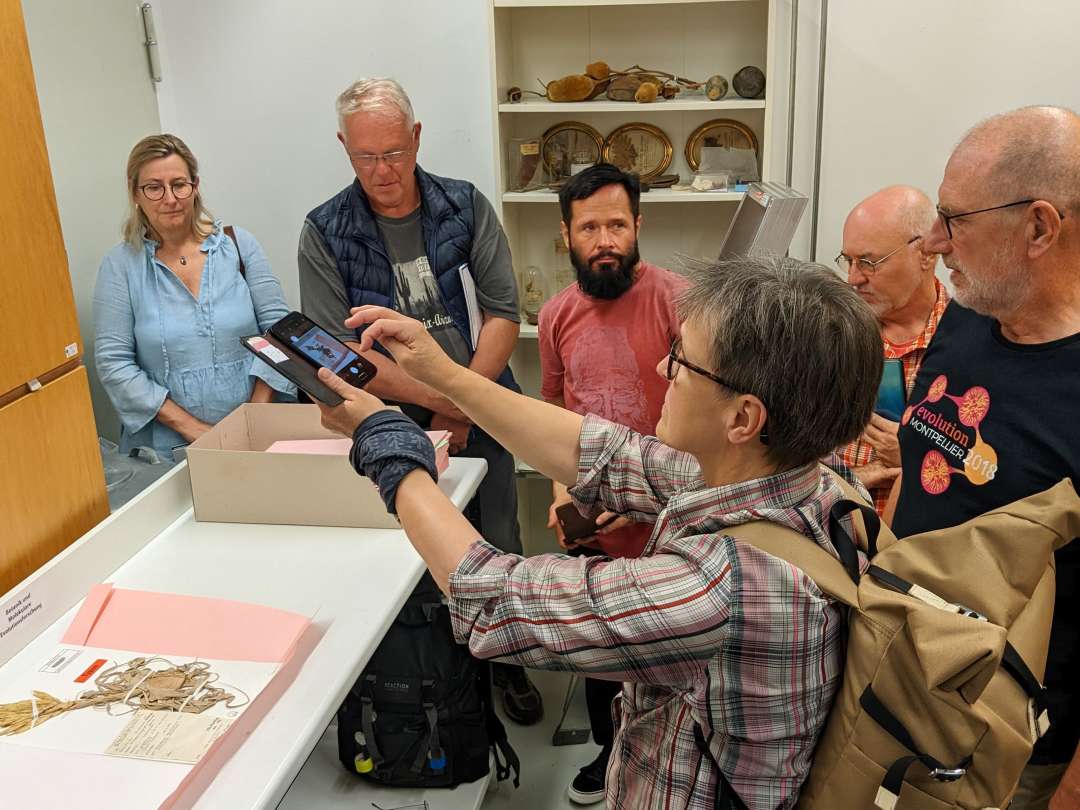
12.09.2022
Dr. Indra Starke-Ottich (Senckenberg’s biodiversity mapping group) and Dr. Thomas Hartmanshenn (Umweltamt Frankfurt/M.) report on Monte Scherbelino and Northpark Bonames, two project areas in the “Cities dare wilderness” project. The lecture took place in Senckenberg on September 7, 2022.
Farewell, thank you and all the best!
20.07.2022On 15th July 2022, Dr. Claudia Pätzold left the Department of Botany and Molecular Evolution to move to a permanent position at the Senckenberg Natural History Collections Dresden. She has been with us since 1st May 2020 as part of the DFG project “Phylogeny, historical biogeography and niche evolution of the neotropical Marcgraviaceae” (project leader Dr. Stefan Dressler) and was responsible for the preparation of sequence data with the 353angiosperm kit and, with her excellent knowledge of phylogenetic analysis methods, above all for the sequence data analysis and interpretation of the complicated genetic processes in Marcgraviaceae. We thank her for the work she has done, look forward to continued good cooperation and wish her all the best at the new place of work.
14.07.2022
During his stay in Frankfurt, Prof. Dr. Sebsebe Demissew, Professor at the University of Addis Ababa and Director of the Gullele Botanical Garden, Ethiopia, together with Dr. Karen Hahn, Institute for Ecology, Evolution and Diversity of the Goethe University, visited the Herbarium FR on July 12, 2022. He was particularly interested in Eduard Rüppell’s type specimens from Ethiopia, the Sesame/Aquila database, and the African Plants portal.
07.07.2022
Dr. Stefan Dressler attended the 22nd AETFAT congress in Livingstone, Zambia. He co-chaired the session on databases together with Dr. Siro Masinde from the Kenyan Museum of Natural History Nairobi and gave a presentation on the African Plants Photo Guide database (incl. poster) which was very well received. Before the congress he spent a week in the field in the Mutinondo Wilderness in the Northern Province.
01.07.2022
On June 30, the entire Taunus herbarium – about 10,000 specimens – has now been handed over to the Herbarium Senckenbergianum Frankfurt (FR). This herbarium of the Taunus Mapping Project forms the documentary basis for the compilation of the “Taunusflora”, which was launched on 10 May 2022 after 25 years of work. Kurt Baumann (†), Heinz Kalheber and Dr. Thomas Gregor from our department participated in this project group.
30.05.2022
On 25 May, Christian Printzen gave a lecture in the Senckenberg lecture series „Heute schon geforscht? Mit Citizen Science gemeinsam Wissen schaffen“ in which he highlighted the contributions and achievements of volunteer citizen scientists in the history of Senckenberg, with a special focus on the collections of the Herbarium Senckenbergianum (FR). The talk can be viewed on YouTube.
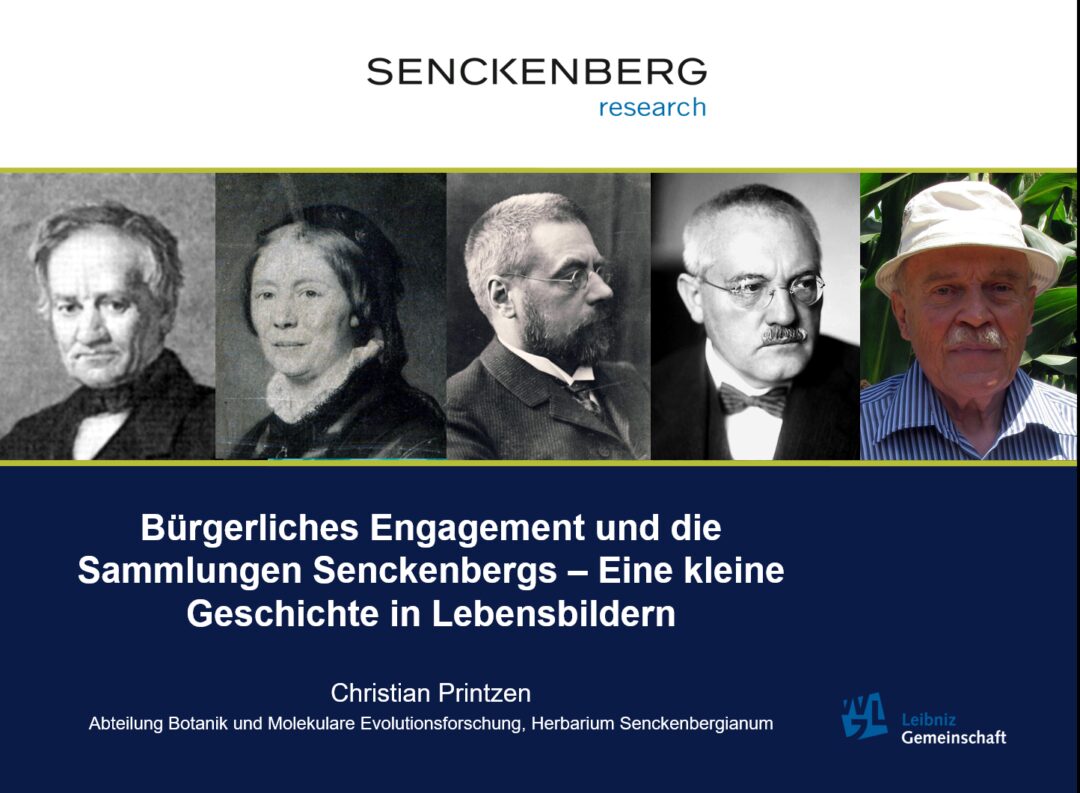
On 28 April 2022, a delegation from Rwanda visited the Herbarium Senckenbergianum: Prof. Beth Kaplin and Prof. Elias Bizuru from the Center of Excellence in Biodiversity & Natural Resource Management (CoEB) of the University of Rwanda also discussed possible botanical cooperation projects.
Lost places
20.04.2022
The planet e. documentary „Das Geheimnis der vergessenen Ruinen – Wie die Natur Lebensräume erobert“ reports, (in German) among other things, about Monte Scherbelino and Nordpark Bonames. There, “wilderness”, i.e. undisturbed development of plant and animal life, is allowed. Biotope mapping has investigated and documented the development of biodiversity over the years.
07.04.2022
Dr Juraj Paule has left the department after more than ten years as manager of the Molecular Laboratory for Berlin. There he will work as curator at the Herbarium Berolinense (B).
A warm welcome!
21.01.2022
Since January 1st 2022, Luisa Otto, museum technical assistant and graduate of the Senckenberg School, is a new colleague in our department. She is working on a third-party funded project on biodiversity in the forests around Frankfurt Airport, where several hundred samples have been collected. (expected end of project: 12/2023)
Christmas party non-virtual!
16.12.2021
The Botanical Department held a Christmas party in presence this year, on a small scale and with the greatest security precautions, also to bid farewell to our Technical Assistant Sandra Wilwert (4th from right), who is leaving us at the end of the year. However, she will remain with Senckenberg as she is moving to the Messel Research Department. All the best and Merry Christmas to all!
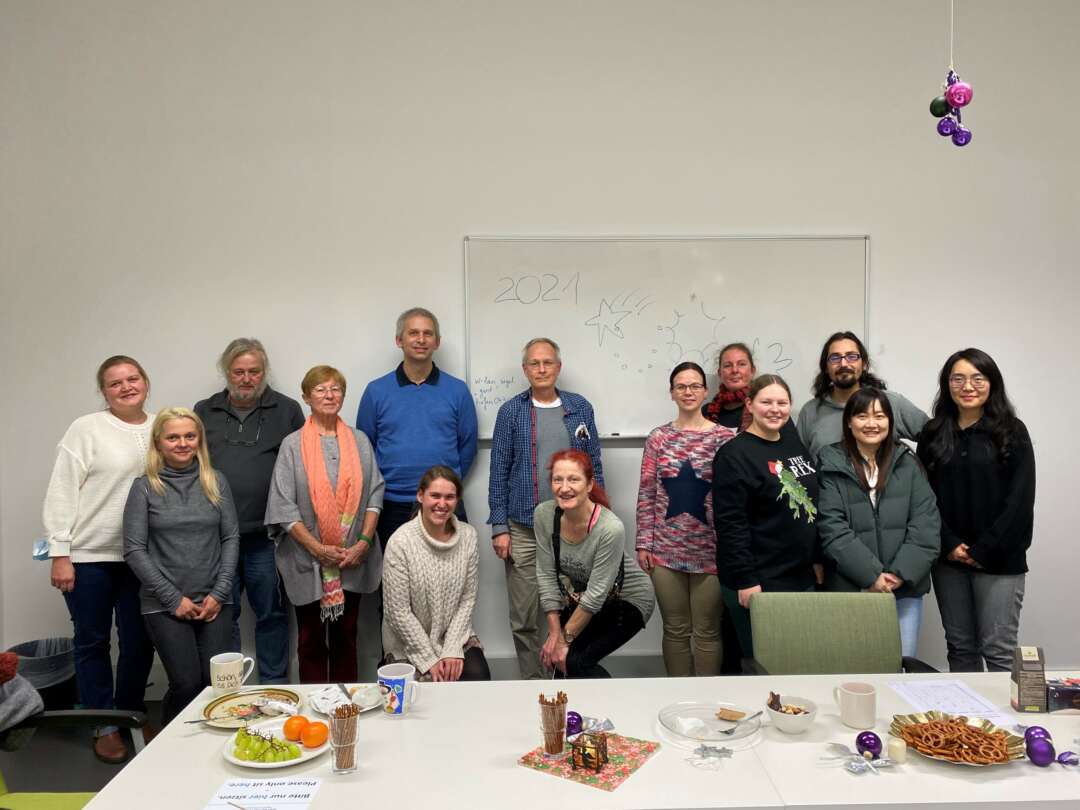
Research stay on Isla Navarino
10.12.2021
On 23 Nov. Dr. Christian Printzen started from Frankfurt to catch up on his research stay on Isla Navarino in the extreme south of Chile, which had been planned for over a year and postponed due to the covid pandemic. He will be studying the diversity of lichens there until 22 Feb. 2022. He lives and works at the Centro de Investigación Puerto Williams of the Universidad de Magallanes. Since 2017, Senckenberg has had a cooperation agreement with the Fundación Omora, which is also involved.
The Magellanic Region comprises the southernmost forests on earth. At almost 1200 m above sea level, the central mountains of Isla Navarino (the “Dientes de Navarino”) also include high-Andean ecosystems and extensive moorlands. The biogeography of the area is complex. Lichens with predominantly South American, Antarctic and Northern Hemispheric distributional ranges are occurring in the region. The area is already known as a diversity hotspot for mosses, but the lichen flora has not yet been sufficiently explored.
The trip is accompanied by our freelancer Dr. Birgit Kanz in a blog.
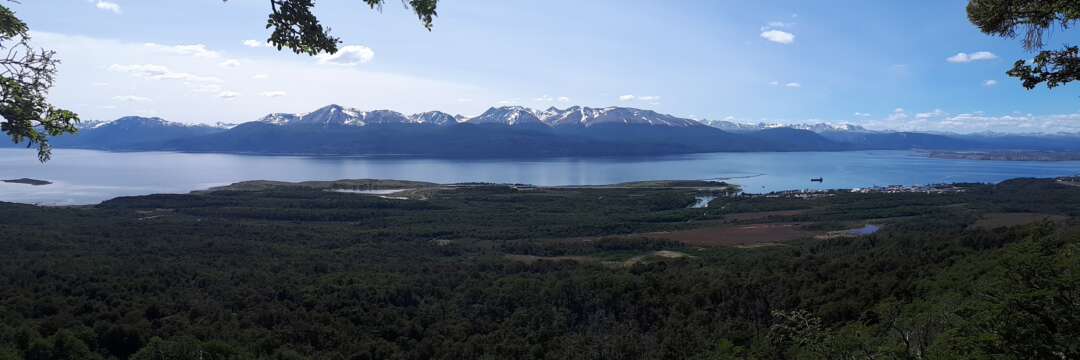
We reach the 10 thousand!
11.11.2021In our project “African Plants – A Photo Guide” we have now illustrated 10,000 species! There are about 60,000 species on the African mainland. Still a little way to go … We are happy anyway.
Georg Zizka retired
12.10.2021
On September 30, 2021 Georg Zizka retired, since 1995 Head of the Department and Section Phanerogams I and in personal union Professor of Plant Diversity and Evolution at the Department of Biosciences, Goethe University Frankfurt. As of October 1, 2021, he has been appointed an Honorary SGN Fellow in our department. Scientific plans for the future are the completion of ongoing projects, e. g. on Bromeliaceae and Marcgraviaceae, and outstanding publications.
Retreat Herbarium Senckenbergianum in Bad Frankenhausen
11.10.2021From 20-22 Sept. 2021, our annual botanists’ meeting took place in Bad Frankenhausen, this time again in presence. Apart from important coordination and project discussions, an essential part was an excursion programme that opened up this floristically and culturally very interesting Kyffhäuser area in the middle of Germany to us participants. Dr. Jürgen Pusch, Head of the Kyffhäuser Nature Park Administration, proved to be a committed and knowledgeable guide, and we would like to thank him and the colleagues from Görlitz in particular for the organisation.
Summer School in Rwanda
11.10.2021
Lilith Weber, Marco Schmidt and Stefan Dressler taught at a Summer School in Rwanda from 23 Aug. to 5 Sept. 2021. The course took place in Nyungwe National Park in SW Rwanda, an impressively large, semi-natural rainforest. Botany of seed plants, lichenology and botanical collecting techniques were taught. The field course was organised by the Center of Excellence in Biodiversity and Natural Resource Management at University of Rwanda in Huye together with Dr Viola Clausnitzer, Görlitz.
Exhibition “Neue Wilde” in the Wissenschaftsgarten (Science Garden, Riedberg)
27.08.2021
Since August 13, the exhibition “Neue Wilde – Globalisierung in der Pflanzenwelt”, realized by the Association of Botanical Gardens, informs about migrations in the plant world due to human influence. The topic is particularly interesting in cities and is a central working area of biodiversity mapping. Extensive information on the immigration history of plant species in Frankfurt is provided by our online “Flora von Frankfurt”.
For information in the media (in German), see rheinmaintv and Frankfurter Rundschau.
Workshop on German-Chilean collaborations in Natural laboratories in the extreme zones of Chile
17.08.2021
Dr. Christian Printzen presented his plans to study the lichen flora of Isla Navarino in southern Chile at a workshop organised by the Rachel Carson Center (RCC) of LMU Munich on 11 August entitled “Natural laboratories in the extreme zones of Chile: From Hand-Lenses to Telescopes to explore the Micro- and Macro-Cosmos today”.
Lichens are sensitive indicator organisms for ecological changes. Studying them in the Cape Horn Biosphere Reserve will help to better understand the effects of man-made environmental changes on natural ecosystems. Senckenberg has had a cooperation agreement with the Chilean “Fundación Omora” since 2018. As part of the scientific exchange, the lichen herbarium of the Universidad de Magallanes (UMAG) in Punta Arenas shall be supplemented and a virtual university course on general and applied lichenology be developed.
Collection takeover
14.04.2021On April 8th 2021 the first batch of the herbarium Gerold Hügin was gifted to the Herbarium Senckenbergianum (FR) by his sister in Denzlingen. This part was already very extensive (approx. 7500 specimens) and fit exactly into the car. The Alchemillas are to be expected in part 2.
Cities dare wilderness
13.04.2021
At the end of the funding period (2017-2021), the project “Cities dare Wilderness”, funded by the Federal Agency for Nature Conservation, now offers a summary of the results and a colourful range of information – e. g. numerous lectures and short films – on biodiversity in the three participating cities Dessau-Roßlau, Frankfurt and Hanover on its homepage. An important topic is also the possibilities and limits of “wilderness” in populated areas and its significance for and effect on humans.
“Herbarium week”
07.04.2021
Before Easter, we advanced our FloraWebPlus project, run jointly with the Görlitz seed plant botanists, in a “herbarium week”. Botanists must go into the field: it was also time for a short excursion to the Schwanheim dunes, where the rare dwarf grass Mibora minima was just in flower.
06.04.2021
On 29 March 2021, Prof. Dr. Hans Joachim Conert, long-time head of the Senckenberg Botanical-Palaeobotanical Department, was buried at the municipal cemetery in Berlin-Heiligensee. We will honour his memory.
Congratulations!
10.03.2021
On 10 March 2021, Tetiana Lutsak successfully completed her disputation and thus completed her doctorate on the lichen group Cetraria aculeata s. l. We wish her all the best for the future career, which she already pursues working in the Netherlands for three years.
Prof. Dr. Hans Joachim Conert, 16 May 1929 – 24 February 2021
03.03.2021
As we learned yesterday, the long-time head of the Department of Botany-Palaeobotany (now Botany and Molecular Evolutionary Research) passed away in Berlin at the age of 91.
Conert was born in Sommerschenburg (Saxony-Anhalt), attended school in Magdeburg and completed an apprenticeship there as a machine fitter. This was followed by studies in biology and chemistry at the Free University of Berlin and finally a dissertation with the agrostologist Prof. Dr. Robert Pilger on the subject of “The Systematics and Anatomy of the Arundineae”. 1956-59 followed a stipend from the German Research Foundation, where he worked on the systematics of the Poaceae and Xyridaceae. In 1960, he was appointed to the Botanical-Palaeobotanical Department of the Senckenberg Research Institute and Natural Museum in Frankfurt, and in 1966 he was finally appointed head of the department as successor to the palaeobotanist Prof. Dr. Richard Kräusel. Conert was the first full-time scientist in the department. In 1994, he retired and became an honorary member of the SGN. For several years he still worked regularly at the Institute, completing projects such as the editing of the Poaceae for the “Hegi”. Eventually Conert and his wife Herta moved back to Berlin, where one of their two sons and grandchildren also live. In 2009 an international symposium organised by the Department on the occasion of his 80th birthday brought him back to Frankfurt.
Conert’s scientific work focused on the Poaceae and – to a much lesser extent – the Xyridaceae. In addition to a large number of taxonomic-systematic scientific publications, two comprehensive standard works also originate from his pen, namely the treatment of the Poaceae in the 3rd edition of the “Illustrated Flora of Central Europe” founded by Gustav Hegi (Vol. 1, Part 3, 1998) and “Pareys Gräserbuch” (2000). For decades he was one of the editors of “Hegi”. Besides the grasses of Central Europe, it was the Poaceae of Africa that particularly occupied him. He made longer field trips to Nigeria, Mexico, Cape Verde, the Canary Islands and southern Spain.
From the very beginning, Conert also fulfilled the nowadays strongly propagated duties of a scientist in the area of communication/transfer to a broader public, be it as the author of numerous popular science articles or as the co-editor of “Natur und Museum” for decades. When the request for a “biotope mapping” was brought to Senckenberg by the city of Frankfurt, he took on the task of setting up a long-term biodiversity monitoring of the city area and led this project until his retirement from active service.
At a time (late 1970s and early 1980s) when there were hardly any links between Goethe University and Senckenberg, Conert took on a lectureship in the Department of Biology and was able to interest numerous students in taxonomy and systematics, who went on to write their final thesis in the Senckenberg Department of Botany. This resulted in many state examination and diploma theses as well as several dissertations. Conert’s competence, but also his calm, approachable and friendly manner made him an excellent teacher. His very successful work was an important reason for the then increasing (re)rapprochement of the University and Senckenberg in the field of biology up to a cooperative professorship in 1995, which has been followed by many others to this day. At the symposium on the occasion of his 80th birthday, the vast majority of his students were present.
As a scientist trained at the herbarium of the Botanic Garden and Botanical Museum Berlin-Dahlem (BGBM), Conert was aware of the importance of the collections for systematics and taxonomy and for science per se, as well as the social and cultural mission that arises for Senckenberg from the significance of the unique collections that have been publicly funded for many decades. He has intensively supervised and developed the herbarium, especially the Poaceae, scientifically, also by openly involving citizen scientists. Some of these have been loyal to the department for many decades and contribute significantly to the development of the collection.
Some of us still experienced Hans Joachim Conert as a teacher or supervisor and also remember an appreciative, affectionate man who took every person seriously and was aware of the responsibility for his staff and students. We are glad and grateful to have known him and to have worked with him.
P. S. A detailed obituary is in preparation.
Orchids of Australia
26.02.2021
Former member of our department Dr. Katharina Nargar (née Schulte) joined the Australian Tropical Herbarium in Cairns, Queensland in 2010. She has switched her research there from bromeliads to orchids. Here is a media report about her and her work:
Senckenberg School
18.02.2021
A report on the traditional Senckenberg School in Frankfurt recently appeared on Rhein-Main-TV. Christian Printzen, head of the school educating museum technical assistants for natural science research institutes, reports on orientation and content of the training:
Congratulations!
28.01.2021
On December 11, 2020, Elisa Lagostina successfully completed her disputation in the online format from Italy. Title of the thesis: “Dispersal and genetic exchange of lichen populations between the Maritime Antarctic and southern South America (with a focus on human impact)”. We wish her all the best for the future.
News on COVID-19
27.01.2021
Due to the current regulations on COVID-19, the department will remain closed for visiting researchers and volunteers until probably 14 February 2021.
Done!
11.12.2020
The evaluation of the SGN by the WGL which takes place every seven years happened in the unusual virtual form because of COVID-19. Here are some of the posters on the evaluation (pdf format) in which representatives of our department were directly involved:
- Collectomics and the DFG priority program 1991 „Taxon-omics“
- Revision of the angiosperm family Quiinaceae (Malpighiales)
- Leaf venation networks that contradict a global scaling rule
- Exploring the genomic basis of an underwater tape: the evolution of silk biosynthesis and associated behaviour in caddisfly larvae
- Long-term ecological research (LTER): the SGN observatories & national, European and global leadership
- Polyploidy in plants is linked to climate
- Targeted object digitization for applied botany and conservation
A warm welcome!
17.09.2020
We are very pleased to welcome Ms Sandra Wilwert as technical assistant in the section cryptogams replacing Viola Ziller during her parental leave. Ms. Wilwert has completed the Senckenberg School for technical assistants in museums and is therefore familiar with the many aspects of the collection management.
Project conference in Dessau-Roßlau
17.09.2020
The project “Cities venture wilderness”, in which municipal offices and working groups from Dessau-Roßlau, Frankfurt and Hanover are involved, held a project conference in the Bauhaus city from 14-16. Sept. 2020.
Central topics were the final report (project duration 2016-2021), evaluation of the scientific results and a summary of the various public relations activities. An extensive bicycle excursion to the wilderness areas of the city and the activities to protect wild fruit species rounded off the programme.
As already experienced at previous meetings, the bicycle-friendliness of the city and the fantastic nature of the Dessau region (biosphere reserve middle Elbe) are impressive. Many thanks to the organizers.
Project “Cities dare wilderness” attracts interest in the media
24.08.2020
Deutsche Welle also reports in an English-language article on biodiversity in cities about the project “Cities dare wilderness”, which can be read here: Biodiversity blooms in cities when green spaces go wild.
“Cities dare wilderness” awarded again
24.08.2020
The project “Cities dare wilderness” (“Städte wagen Wildnis – Vielfalt erleben”) supported by the German Federal Ministry for the Environment, Nature Conservation and Nuclear Safety (BMU) has once again received an award as part of the UN Decade of Biodiversity. The project ends in 2021, the goal is to preserve the “wilderness areas” beyond the project period.
Volunteering at the Botany Division
15.07.2020
Our appointed volunteer Dr. Gerhard Winter gave an interview to “Natur • Forschung • Museum” which touches also his bryological work in our Herbarium Senckenbergianum Frankfurt/M. Click here for the interview (in German).
Congratulations!
14.07.2020
We congratulate Dr. Sarah Schießl-Weidenweber on her habilitation at the Justus Liebig University Gießen.
New buildings for Senckenberg Frankfurt
09.07.2020
A short film provides a review of the construction work at the Frankfurt site and an insight into the new collection and research rooms, including the Herbarium Senckenbergianum. Click here for “Das neue Senckenberg” on YouTube (in German).
22.05.2020
The division will be reopened for volunteers and guest researchers (with restrictions to comply with the hygiene concept) from 25.05.2020.
Welcome!
11.05.2020
Beginning May 2020 Dr. Claudia Pätzold started as a Post-Doc in our division. She works in the project “Phylogeny, historic biogeography and niche evolution of the neotropical Marcgraviaceae – a model case of swift morphological diversification and speciation by flower-pollinator-interaction” (project leader: Dr. Stefan Dressler) with funding from DFG (Deutsche Forschungsgemeinschaft). We look forward to the collaboration.
18.03.2020
Due to the Senckenberg-wide regulations and current recommendations in connection with the corona virus epidemic, the Division of Botany and Molecular Evolutionary Research is closed since 16th March 2020 until further notice for volunteers, visiting researchers and interns.
Best wishes for health, especially for the people in the particularly affected areas.
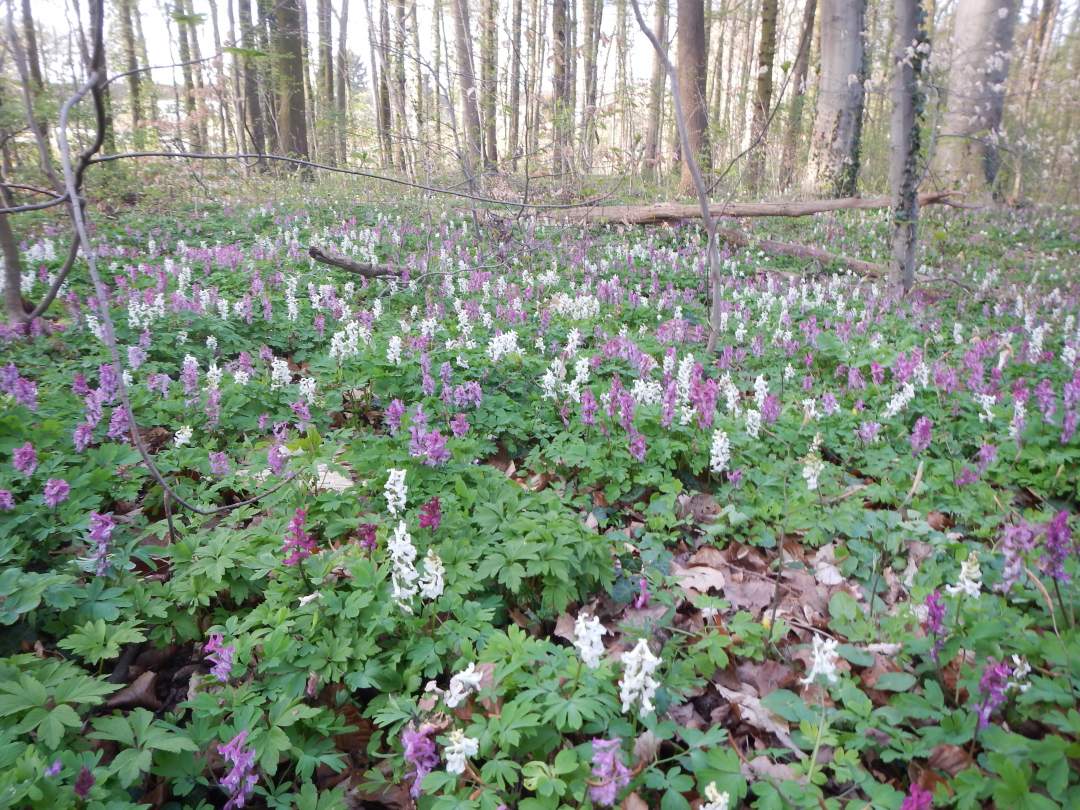
2019
Wondering if it’ll be a bestseller …?
20.12.2019
Seen in a Frankfurt bookstore on 17 Dec 2019.
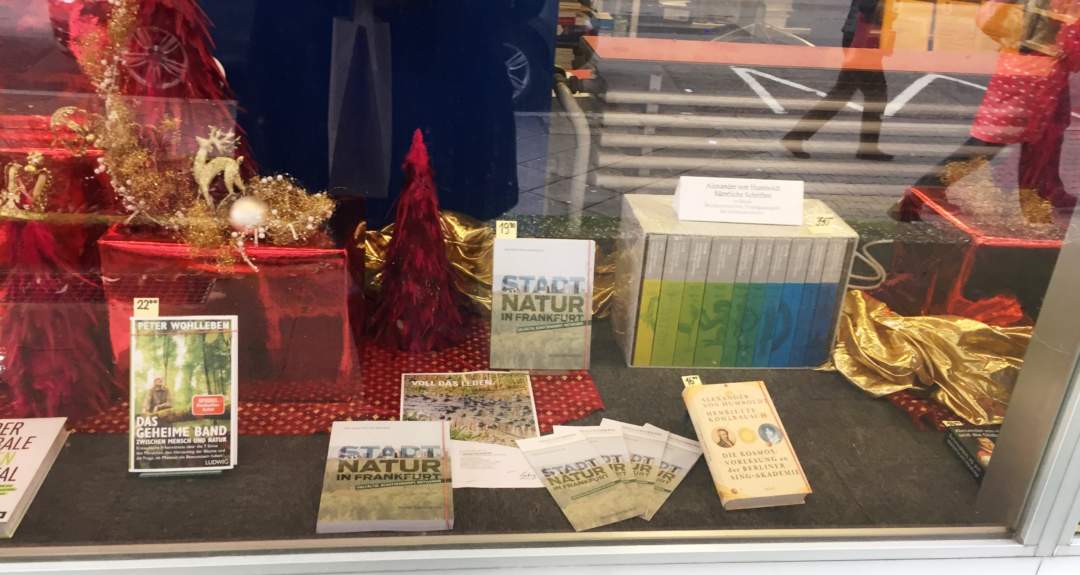
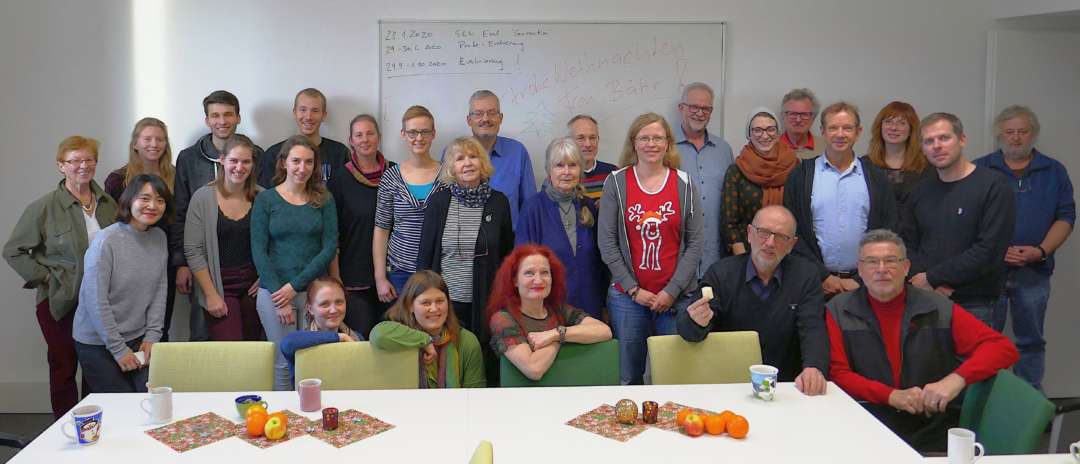
Our christmas party took place on 18 Dec 2019 with lectures about collecting trips to Japan and Malawi, the evolution of our christmas cards, a quiz and of course good food and drinks.
New Red List of Ferns and Seed Plants of Hesse published
05.12.2019
On 6 Nov. 2019, the 5th edition of the Red List of Hesse’s fern and seed plants has been published. Coordination and editing were carried out by the two Senckenberg scientists Indra Starke-Ottich and Thomas Gregor as part of their commitment to the Botanical Association for Nature Conservation in Hesse (BVNH). Dirk Bönsel, a long-standing member of the biodiversity mapping working group, has been in charge of the Hessian region southwest. The herbarium Senckenbergianum with its large collection of Hessian plants is an indispensable basis for the evaluation of the species since the long-term development can often only be reliably reconstructed on the basis of herbarium evidence.
17.10.2019
The Senckenberg stall at the 2019 Frankfurt book fair with the newest publication: „Stadtnatur“ ist being presented by Isabel Clasen (Publications Dept.) and Indra Starke-Ottich (Botany Dept.). This book is the third in a row about Frankfurt’s nature within the city limits.
“Gardens of Horror”
07.10.2019
Our former division member Ulf Soltau (diploma 2002) deals with biodiversity in front gardens. See his book publication: Soltau, U. (2019). Gärten des Grauens, 128 S.; Eichborn Verlag.
02.10.2019
Nani Goginashvili from the The Agricultural University of Georgia and Irina Tvauri from the LEPL Scientific-Research Center of Agriculture visited the division and the Herbarium Senckenbergianum between 23-28 Sept 2019 in course of the cooperation with Juraj Paule.
26.09.2019
In the course of the BMBF project EvoBoGa aiming at establishing barcoding in Bromeliaceae Georg Zizka attended the International Barcode of Life conference 16-21 June 2019 in Trondheim.
26.09.2019
Within the framework of the project meeting “Cities dare wilderness” (project funding BMU/BfN) from 19-20 Sept 2019 in Dessau-Roßlau (Senckenberg participants: Indra Starke-Ottich, Georg Zizka) the Muldeauen area were paid a visit.
Senckenberg botanists meet in Görlitz
25.09.2019
From 17-19 Sept 2019 the Senckenberg botanists from Frankfurt, Görlitz, Weimar and Wilhelmshaven met in Görlitz. Important topics were research cooperation and joint projects, as well as the cross-location coordination of processes and development concepts in the collection area. An excursion to the biosphere reserve Lausitzer Teichlandschaft took place on Sept 18th which also offered some botanical and zoological delicacies.
Many thanks to the colleagues in Görlitz for the successful organization!
Excursion to the Kühkopf
25.09.2019
On September 3rd, 2019, an excursion of the division to the Kühkopf area took place with the participation of of our volunteers. The biggest Hessian nature reserve and the nature conservation centre was kindly demonstrated by Ralph Baumgärtel, Director of the Environmental Education Centre.
Many thanks to him and to Thomas Gregor for the organisation.
Once upon a time …
06.08.2019
The demolition of the old building of the Division of Botany and Molecular Evolution on the former Senckenberg site at the Kuhwaldstraße 55 is in full swing. However, in view of our beautiful new rooms and, above all, the larger, modern collection rooms in the Jügelhaus, we do not look back with too much melancholy …
News 2019
(04.06.2019) Expedition to Malawi
A three-week expedition led various members of the division to Malawi.
Together with Dr. Florian Jabbour from the Muséum national d’histoire naturelle in Paris and Hassam Patel from the National Herbarium in Zomba, Elke Faust, Dr. Marco Schmidt and Dr. Stefan Dressler from Frankfurt were looking for lark-spurs.
The aim of the project is a more precise knowledge of the taxonomic structure of the afromontane Delphinium species. The trip, financially supported by the National Geographic Society, was extremely successful. In addition to collecting the taxa we were looking for, a lot of pictures were taken for the African Plants photoguide project.
(27.05.2019) Award
Our colleague Rainer Döring was awarded for his honorary engagement with the Letter of Honour of the State of Hesse and the Silver Plaque of Honour of the city of Nidderau.
Congratulations!
(11.04.2019) Visit from Zanzibar
John Ndege, curator of Migombani Botanic Garden, Unguya Island, Zanzibar, Tanzania, visited us on 4th and 5th April 2019. He studied plants from coastal Kenya and Tanzania but was also interested in general management of a herbarium, since the establishment of a herbarium collection at the Zanzibar garden is among his many tasks.
(09.04.2019) Evo-BoGa meeting in Frankfurt
On 5th April 2019, participants from Berlin, Bonn, Frankfurt (Palmengarten and Senckenberg), Göttingen, Heidelberg and Munich of the “Evo-BoGa” project (BMBF-funded) met in the rooms of the botany division to discuss progress. The aim of the project is to make the living collections of botanical gardens more accessible through a common portal for research, teaching and species protection, and to facilitate the identification of species through the use of molecular methods.
(05.04.2019) Congratulations!
Sascha Heller completed his doctorate on the Evolution of the Bromelioideae on 29th March 2019 with the disputation. Despite him being working outside botany for some time now, a number of planned publications in cooperation with Elton Leme and the “Bromelistas” of the division should now be finalized.
As the youngest member of the division Sabine Rengers son Erik took part in the following reception (non-alcoholic drinks!). We wish Sascha all the best for the future!
(21.03.2019) Google Arts & Culture on herbaria
A short virtual exhibition on the invention and use of herbaria was recently released in the context of Google Arts and Culture. This project was made with the help of the Herbarium Senckenbergianum Frankfurt/M. (FR) and shows some of our collection pieces.
(28.02.2019) Remaining faithful to the bromeliads …
Our former division member Ulf Soltau stayed faithful to the bromeliads and attracted the interest of DB magazine with its appealing mini-greenhouses – in reminiscence to Nathaniel Ward.
(06.02.2019) Coordination meeting of “Cities dare wilderness”
On 4 and 5 February 2019 we hosted the coordination meeting of the BMU project “Cities dare wilderness” in the botany division. 26 persons from Dessau-Roßlau, Hannover and Frankfurt presented the results of the scientific studies on the biodiversity on the “wilderness areas” and the results of the visitor surveys.
The meeting took place in the seminar room of the botany division – here the participants during the workshop “environmental education”.
A short film informs about the aims of the project.
News 2018
(29.11.2018) Klaus Tschira Foundation supports development of Carl Bosch’s moss herbarium
The well-known Nobel Prize winner and former CEO of BASF, Carl Bosch, was not only a successful chemist and manager, but also an enthusiastic naturalist and collector. Since the 1960s, the Senckenberg Research Institute has been preserving his collections of beetles, molluscs, lichens and bryophytes, a total of several 100,000 specimens. The Klaus Tschira Foundation has now granted 87,500 euros to re-mount and make the original moss collection of around 17,000 samples digitally accessible. The project application was prepared mainly by our volunteer Dr. Gerhard Winter. A “Citizen Science Project” in two senses!
(08.11.2018) Networking meeting of Senckenberg botanists and palaeobotanists took place from 5th to 7th November in Frankfurt
27 colleagues from Dresden, Frankfurt, Görlitz, Jena, Weimar took part in this year’s networking meeting, Mona Hoppenrath from Wilhelmshaven was connected on Nov. 5th by video conference. An important topic was the exchange with the Senckenberg palaeobotanists about possible cooperation and future projects.
The conference took place mainly in the very aptly fitted new seminar room. An important part of the program was the exchange of ideas between palaeobotanists and botanists about possible cooperations (here, on the right, Lutz Kunzmann during his presentation).
Further items were reports on planning, construction and moving collections (SNMG is currently planning the new building), project reports, coordination with regards to the curating of the herbarium collections and, above all, considerations on cross-locational strategies and third-party funded projects. Not to forget the coffee and lunch breaks as an important opportunity for exchange on a wide variety of topics.
Especially in Görlitz, the planning of new collection rooms is an important current topic. The new collection rooms of the Botanik Frankfurt found interest, the “new danger” paperfish was also a theme.
The programme was rounded off by a guided tour through the new collection rooms, the science garden at the Riedberg and an excursion to the Schwanheimer Alteichen and to the Rohsee.
The new collection and functional rooms, but also the new guest rooms and the bistro in the Jügelhaus were rated very positive. We are already looking forward to the next meeting in Görlitz (probably June 2019).
(26.10.2018) Move accomplished = Herbarium reopened
Since 1 October 2018, the Herbarium Senckenbergianum Frankfurt/M. (FR) is operational again at its new location. The collections are now all housed in air-conditioned and protected rooms in compact units. Together with the offices the botany division is now located in the Jügelhaus in Mertonstraße in the museum complex at Senckenberganlage 25.
(16.10., ergänzt 17.10.2018) “Monocots VI” conference in Natal
From 6-14th Oct. 2018 Fabian Bratzel, Juraj Paule and Georg Zizka participated in the”6th International Conference on Comparative Biology of Monocotyledons – Monocots VI” in Natal, Brazil, which also included the “2nd World Congress of Bromeliaceae Evolution – Bromevo II” (Abstract volume).
The division was represented with the organization of a session (Recent advances in Bromelioideae systematics) together with our cooperation partner Elton Leme as well as 3 lectures and 1 poster. More than 400 participants provided for an extensive program, excursions led into the coastal forest vegetation on sand (Restinga and elements of the Mata Atlântica).
(08.10.2018) Visit to Helsinki
From 13 to 15 September, lichen curator Christian Printzen visited the Botanical Museum of the University of Helsinki as opponent of Annina Launis, who successfully defended her doctoral thesis on the systematics and conservation of the lichen genus Micarea on 14 September.
The defence took place in the historic Nylander Hall according to old university tradition and was celebrated with an evening reception and dinner in the Botanical Garden.
(05.10.2018) BLAM elects new council
The Bryological-Lichenological Working Group for Central Europe (BLAM) elected a new council at its general meeting on 24 August 2018 in Immensee in the Allgäu (Bavaria). Christian Printzen, in his spare time curator for cryptogams in the Division of Botany and Molecular Evolutionary Research, was elected as the new chairman.
(05.10.2018) DFG-funded project „Lecanomics“ picks up speed
On July 1, Cristóbal Ivanovich from Punta Arenas in Chile took up his PhD position at the division. Cristóbal will investigate the molecular systematics and species delimitations within the large lichen genus Lecanora within the project “Lecanomics” funded by the DFG priority program “Taxon-omics”.
Species of this genus can be found in practically all terrestrial ecosystems worldwide. In the last 50 years alone about 250 new species have been described. The project is supported by a worldwide network of cooperation partners.
On September 20, Yanyun Zhang from Kunming in China joined the Lecanomics team for another year. As part of her doctoral thesis supervised by Prof. Dr. Wang Lisong, she is working on the genus Rhizoplaca in China, which is closely related to Lecanora. From July 19 – August 6, Christian Printzen visited the Iranian partner Prof. Dr. Mohammad Sohrabi to collect samples in forests along the Caspian Sea. The region is known for its well-preserved deciduous forests.
(11.09.2018) Almost done…
The relocation of the Division of Botany and Molecular Evolution Research to the Jügelhaus is expected to be completed in October 2018. The colleagues have been working in the new offices for ten days now. Only the Grunelius-Möllgaard molecular lab and the DNA archive operated by the division are still temporarily housed in the Maria-Sibylla-Merian-Haus and will move to their final location in the Reimersbau in 2019.
(10.09.2018) Forum Citizen Science: “Gemeinsam mehr erreichen”
On September 6 and 7, 2018, Senckenberg hosted the “Forum Citizen Science” with more than 100 participants.
The Botany Division presented two of its Citizen Science projects (Flora von Frankfurt, presented by Indra Starke-Ottich and African Plants – A Photo Guide, presented by Stefan Dressler) and was also involved with a short lecture. The biodiversity databases of the Botany Division have tens of thousands of visitors every year.
(16.08.2018) Natur • Forschung • Museum 148 (4-6)
New contributions to our member magazine “Natur • Forschung • Museum” concerning the use of herbarium specimens:
We congratulate Rainer Döring to his 40th anniversary of working for Senckenberg and thank him for his constant service for our botany division.
(13.04.2018) Meeting of Bryological-Lichenological Working Group for Central Europe (BLAM)
From 20 to 22 April 2018, more than 100 moss and lichen experts from Central Europe will meet at the Senckenberg Natural History Museum in Frankfurt and celebrate the 50th anniversary of the Bryological-Lichenological Working Group for Central Europe (BLAM).
Organised by Dr. Christian Printzen, curator of cryptogams, civil scientists who have made mosses and lichens and their research their hobby meet with experts. The conference programme will be supplemented by excursions to the old Botanical Garden of the Goethe University and the Taunus as well as a small art exhibition.
(13.04.2018) Removal at full swing
Being closed since January the removal of the Herbarium Senckenbergianum Frankfurt is curently taking place: more than 1.2 million specimens are being relocated from the old premises in Kuhwaldstraße to the newly refurbished air-conditioned collection rooms in the old university building (Jügel-Haus) next to the main museum building.
The material is being deep-frozen at – 40°C for one week as a pest-control measure in two freezer containers. The collection removal is planned to last till May 2018, the offices are scheduled to move in Sept. 2018. We expect to open the herbarium again for visitors in October 2018.
Since Apr 9th the Grunelius-Möllgaard-Lab (GML) moved temporarily for 1 year into the Senckenberg Biodiversität und Klima-Forschungszentrum (M.S. Merian building) (SBiK-F gratefully acknowledged). The GML will be welcoming its users on 22nd Apr 2018. Its final location in 2019 will be the lab wing of the Reimersbau.
(13.04.2018) Project meeting at Senckenberg
On 19 March 2018, the first project meeting of the BMBF funded project “Botanical Gardens Plant Collections: Living Resources for Integrative Evolutionary Research” (Evo-BoGa) took place in Frankfurt.
The project is coordinated by the Botanical Garden and Museum Berlin-Dahlem (BGBM), the aim of which is to make the collections of cacti and bromeliads in German Botanical Gardens more accessible and usable.
Project partners are University of Heidelberg (Prof. Dr. Marcus Koch) and the Senckenberg Division of Botany (Juraj Paule, Georg Zizka). We use molecular methods to determine bromeliads and reconstruct the phylogeny. Since 1st Feb. 2018, Dr. Fabian Bratzel employed in this project, Mrs. Nadine Cyrannek is writing her master thesis on this topic.
(19.02.2018) Collecting trip to south Chile and Livingston Island
Senckenberg botanist Christian Printzen is currently sampling lichen populations for his DFG project “Dispersal and genetic exchange of lichen populations between Patagonia and the Antarctic Peninsula”. After a week of field work in southern Chile he embarked on 17 February together with his colleagues Ulrike Ruprecht (University of Salzburg, Austria) und Ulrik Söchting (University of Copenhagen, Denmark) on the “BIO Hesperides” to Livingston Island.
